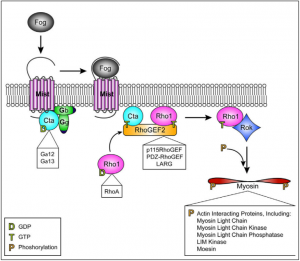In order to form many of the essential structures of the body, such as blood vessels and the gut, a tissue must be able to fold upon itself into a tube. The process to create these structures is driven by cell-shape change, also known as morphogenesis. The folded gastrulation (Fog) pathway is one way cells can be induced to change shape. When a Fog ligand binds to its target receptor, the cytoskeletal network made up of actin and non-muscle myosin II induces constriction of the cell apices, causing the tissue to fold. Through cooperative investigation with computational biologists, a selection of fourteen target proteins with predicted involvement in the Fog pathway and its associated mechanisms were identified and tested for their significance in this pathway by their inhibition in cultured Drosophila melanogaster cells, using RNA-interference knockdown.
Figure 1. The Folded Gastrulation Pathway [Manning et al., 2014]. The Fog Pathway is initiated by the secreted ligand Fog binding to the heterotrimeric G-protein coupled receptor “Mist”, releasing previously-inactive Concertina (Cta) from the two trimer components G? and G? so it may bind to RhoGEF2. The binding of RhoGEF2 causes the small GTPase Rho1 to activate Rho kinase (Rok), which then phosphorylates the NMII regulatory light chain “Spaghetti Squash” (Sqh) and induces contraction of the cell’s apical actomyosin network (Manning et al., 2014).
Preliminary study of the fourteen candidate proteins showed that two in particular, CG and Flapwing (flw), exhibited significantly reduced contractility in knockdown and are therefore the focus of our study. While nothing is known or documented regarding the protein CG, flw has been thus far observed to act as a phosphorylating agent of Sqh and therefore an effector of NMII, similar to the known activities of Rho (Figure 1). Flw is also known to encode the β isoform of phosphatase protein type 1 (PP1), a protein that is highly conserved among all animals (Kirchner et al., 2007).

References:
- Manning A.J., Rogers S.L. 2014. The Fog signaling pathway: Insights into signaling in morphogenesis. Developmental Biology. 394(1): 6-14.
- Kirchner J., Gross S., Bennett D., Alphey L. 2007. The Nonmuscle Myosin Phosphatase PP1β (flapwing) Negatively Regulates Jun N-Terminal Kinase in Wing Imaginal Discs of Drosophila. Genetics. 175(4):1741-1749.
